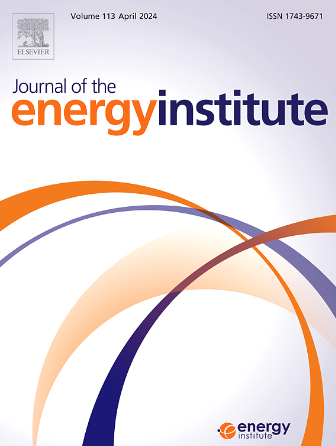利用氮化硼吸附剂在流化床反应器中对废轮胎热解产生的热解油进行脱硫
IF 5.6
2区 工程技术
Q2 ENERGY & FUELS
引用次数: 0
摘要
这项研究的重点是生产六方氮化硼(hBN)作为一种吸附剂,它在脱硫过程中具有很高的效率。合成的 hBN 用于从报废轮胎(ELT)中提取的液体燃料中脱硫。利用傅立叶变换红外光谱、XRD、TGA 和 SEM-EDS 分析对 hBN 进行了表征。液体燃料是在流化床反应器中于 550 °C 氮气流下生产的。脱硫后,燃料的密度、含水量和热值增加,而硫含量和闪点降低,其中硫含量显著降低了 79.23%。脱硫燃料(PS-A)的燃烧特性更好,与柴油的性能非常接近,但与柴油相比,发动机的有效效率略微降低了 1.06%。与柴油相比,PS-A 和预脱硫燃料(PS-B)分别显著减少了 23.28% 和 20.81% 的烟尘排放。此外,PS-A 和 PS-B 的二氧化碳排放量也较低,分别减少了 4.35 % 和 2.00 %。然而,由于燃料消耗量增加,PS-A 和 PS-B 的二氧化碳排放量分别增加了 1.60 % 和 0.86 %。总之,hBN 有效降低了硫含量,并改善了热解液的多项燃料特性。该研究强调了提高 ELT 衍生液体燃料的环境和经济效益,并提出了在实际系统中的潜在应用,为新技术和新项目奠定了基础。本文章由计算机程序翻译,如有差异,请以英文原文为准。
Desulfurization of pyrolytic oils from waste tire pyrolysis in a fluidized bed reactor with boron nitride adsorbents
The study focused on producing hexagonal boron nitride (hBN) as an adsorbent which provides high efficiency in desulfurization processes. The synthesized hBN is used for sulfur removal from liquid fuel derived from end-of-life tires (ELTs). Characterization of hBN was performed using FTIR, XRD, TGA, and SEM-EDS analyses. Liquid fuel was produced in a fluidized bed reactor at 550 °C under a nitrogen gas flow. Post-desulfurization, the fuel's density, water content, and calorific value increased, while sulfur content and flash point decreased, with sulfur content showing a significant reduction of 79.23 %. The desulfurized fuel (PS-A) exhibited better combustion characteristics and closely resembled diesel fuel performance, though it slightly reduced engine effective efficiency by 1.06 % compared to diesel. Both PS-A and pre-desulfurized fuel (PS-B) significantly reduced soot emissions by 23.28 % and 20.81 %, respectively, compared to diesel. Additionally, CO emissions were lower for PS-A and PS-B, with reductions of 4.35 % and 2.00 %, respectively. However, CO2 emissions increased by 1.60 % for PS-A and 0.86 % for PS-B, attributed to higher fuel consumption. Overall, hBN effectively reduced sulfur content and improved several fuel properties of pyrolytic liquids. The study highlights the environmental and economic benefits of enhancing ELT-derived liquid fuels and suggests potential applications in real systems, serving as a foundation for new technologies and projects.
求助全文
通过发布文献求助,成功后即可免费获取论文全文。
去求助
来源期刊

Journal of The Energy Institute
工程技术-能源与燃料
CiteScore
10.60
自引率
5.30%
发文量
166
审稿时长
16 days
期刊介绍:
The Journal of the Energy Institute provides peer reviewed coverage of original high quality research on energy, engineering and technology.The coverage is broad and the main areas of interest include:
Combustion engineering and associated technologies; process heating; power generation; engines and propulsion; emissions and environmental pollution control; clean coal technologies; carbon abatement technologies
Emissions and environmental pollution control; safety and hazards;
Clean coal technologies; carbon abatement technologies, including carbon capture and storage, CCS;
Petroleum engineering and fuel quality, including storage and transport
Alternative energy sources; biomass utilisation and biomass conversion technologies; energy from waste, incineration and recycling
Energy conversion, energy recovery and energy efficiency; space heating, fuel cells, heat pumps and cooling systems
Energy storage
The journal''s coverage reflects changes in energy technology that result from the transition to more efficient energy production and end use together with reduced carbon emission.
 求助内容:
求助内容: 应助结果提醒方式:
应助结果提醒方式:


